Like others who had the privilege of serving as U.S. ambassador in Beirut, I often took the downhill walk from the official residence to a modest memorial nearby. There, like my predecessors and successors, I presided over anniversary remembrances to honor those who lost their lives serving the U.S. government in Lebanon: 63 people slaughtered in the April 1983 embassy bombing; 241 Marines and other U.S. service personnel murdered in the October 1983 Marine Barracks bombing; 23 (including Lebanese visa applicants) killed in the October 1984 bombing of the temporary embassy in Awkar, East Beirut; individuals held hostage, tortured, and killed for their service to the United States; a Navy Seabee murdered and dumped on the tarmac during a 1985 plane hijacking.
The emotional reunions of the embassy’s Lebanese employees, many retired, who survived the bombings, along with the relatives of their colleagues who did not, made these remembrances particularly poignant. The story of an Armenian-Lebanese always touched me: She still toiled for the embassy during my 2004 to 2008 tenure, more than 20 years after she had been left for dead in April 1983 and sent for medical care only when a morgue worker glimpsed a slight twitch. And what did the embassy’s Lebanese commercial specialist tell his mother, when he accepted a job at the very compound where his father had worked and then been killed in 1984? While we did not in those days have many Marines visiting Beirut, whenever we did, it was a special but somber honor for me to accompany the visitor to pay respects at the memorial.
The remembrance commemorations also prompted reflections on the history and power of Hezbollah, the presumed (and in some cases indicted) author of the murders of all of the hundreds of victims—American and Lebanese—whose names were inscribed on the embassy’s memorial. Most were killed by the suicide bombings that Hezbollah did more than any other group to popularize in the modern era. Hezbollah’s methods have evolved as its military and political powers and sophistication have expanded since the mid-1980s, with Lebanon itself rather than American citizens now held hostage. But then as now, Hezbollah serves as the most successful, and the most deadly, export of the 1979 Iranian revolution.
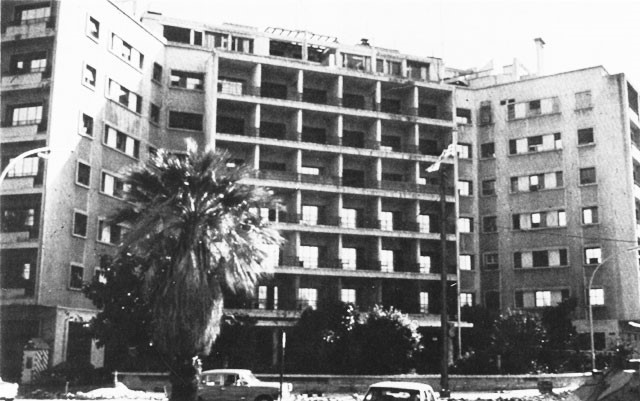
Hezbollah’s origins: Iran seizes the opportunity
Hezbollah emerged during the chaos of Lebanon’s civil war. As Lebanese factions, Palestinians, Israelis, Syrians, and various proxy powers destroyed the country, the ground was fertile for Iran’s post-1979 revolutionary leaders to demonstrate that their example could be replicated in the Arab world, by exploiting long-standing grievances of Lebanon’s Shiite Muslim underclass.
In the complicated balance of the so-called confessional system adopted in 1943 upon Lebanon’s independence, government positions are allocated according to religious sect. These are apportioned by the demographic weight of each group as reflected in a now wildly outdated 1932 census that, given the political implications for Lebanon’s shrinking Christian population, has never been updated. Thus, the president of the republic is held by a Maronite Christian, the prime minister comes from the Sunni Muslims, the speaker of the parliament must be Shiite Muslim, and so forth. Originally, government positions and parliamentary seats were divided in a 6-5 ratio favoring Christians over Muslims; the 1989 Taif Agreement ending Lebanon’s civil war amended this to 50-50. Further divisions allow for representation of Lebanon’s 18 recognized religious sects or confessions (e.g., the Muslim 50 percent share is divided between Sunnis, Shiites, Druze, and Alawites, and the Christian half, while dominated by the Maronites, has reserved slots for the other Christian denominations).
 Confessional allocations aside, Lebanon’s Maronite-Sunni elite (and even some traditional Shiite feudal families) tended to treat the Shiites with disdain and neglect. Enmeshed in poverty and high rates of illiteracy, Shiite peasants concentrated in the south also suffered disproportionately from the Palestinian-Israeli conflict, as the Palestine Liberation Organization (PLO) attacked Israel from southern Lebanon, and the Israelis retaliated in kind. Given years of PLO abuses, Shiite residents of the south briefly welcomed the 1982 Israeli invasion, although Israeli tactics quickly alienated them, driving thousands from ancestral villages to the slums of Beirut’s impoverished southern suburbs.
Confessional allocations aside, Lebanon’s Maronite-Sunni elite (and even some traditional Shiite feudal families) tended to treat the Shiites with disdain and neglect. Enmeshed in poverty and high rates of illiteracy, Shiite peasants concentrated in the south also suffered disproportionately from the Palestinian-Israeli conflict, as the Palestine Liberation Organization (PLO) attacked Israel from southern Lebanon, and the Israelis retaliated in kind. Given years of PLO abuses, Shiite residents of the south briefly welcomed the 1982 Israeli invasion, although Israeli tactics quickly alienated them, driving thousands from ancestral villages to the slums of Beirut’s impoverished southern suburbs.
Meanwhile, the Multinational Force in Lebanon (consisting of military personnel from the United States, France, Italy, and the United Kingdom) established in 1982 to oversee the evacuation of the PLO from Lebanon was increasingly viewed as a partisan belligerent rather than a neutral player, especially after the September 1982 assassination of President-elect Bashir Gemayel.
The Iranian mullahs…had a perfect stage on which to export their revolutionary drama.
The Iranian mullahs thus had a perfect stage on which to export their revolutionary drama: an increasingly disliked Western coalition on the ground; a brutal Israeli occupation and victimized Palestinians in squalid camps; the distracting chaos of an on-going civil war; and—most importantly—an alienated and despised Shiite population desperate for political and economic salvation and security. An earlier attempt at awakening Shiite political activism by the charismatic Shiite cleric Iman Musa Sadr lost its unique momentum with Sadr’s disappearance during a 1978 Libya visit. Albeit with more dangerous intent, Iran picked up what Sadr started and transformed Shiites from underclass to what today is Lebanon’s most powerful political force, one willing to impose its will on the country—including, if needed, by assassinations and militia force.
Conveniently for the newly minted Islamic Republic of Iran, fighting the “Imperialists” and “Zionists” could bolster the Shiite fortunes in Lebanon simultaneously with enhancing the revolutionary reputation of Iran’s government at a time when it was enmeshed in war with Saddam Hussein’s Iraq. Initially hardly noticed in the “noise” of the Lebanese civil war, Iranian Revolutionary Guards (as many as 1,000) established training camps in the Biqa’ Valley in the early 1980s. Iran committed to Shiites tens of millions of dollars (some estimates exceed $200 million) annually to cover salaries and services that the Lebanese state neglected to extend. As opposed to the corruption and cronyism of traditional Lebanese leaders, Hezbollah cultivated an image of crisp efficiency and honesty. But by 1985, when Hezbollah’s initial manifesto (calling, among other things, for the establishment of an Iran-style Islamic republic in Lebanon) was issued, the group was already notorious internationally for its methods of simultaneous suicide attacks, later copied by other terrorist groups, and for its hostage-taking.
For Iran, Hezbollah was already a success story by this point. Hezbollah claimed credit for the departure of U.S and French military personnel in 1984 and the 1985 retreat of the Israelis from Beirut to a security zone in southern Lebanon. Hezbollah’s seizure of hostages gave Iran leverage, with the Reagan administration’s attempts to explain away the Iran Contra scandal by claiming the arms sales to Iran were intended to secure the release of Americans from Hezbollah. While Hezbollah leaders today downplay this bloody legacy of suicide bombing, hijacking, hostage-snatching, torture, and murder, this history foreshadows Hezbollah’s subsequent success in using Israeli hostages and remains to secure the release of Palestinian and Lebanese prisoners from Israeli custody. Similar to 1985, Hezbollah also declared victory for “the resistance” in forcing the Israeli withdrawal from southern Lebanon in 2000 and for having survived the Israeli ground and air attacks in the devastating summer 2006 war that Hezbollah provoked.
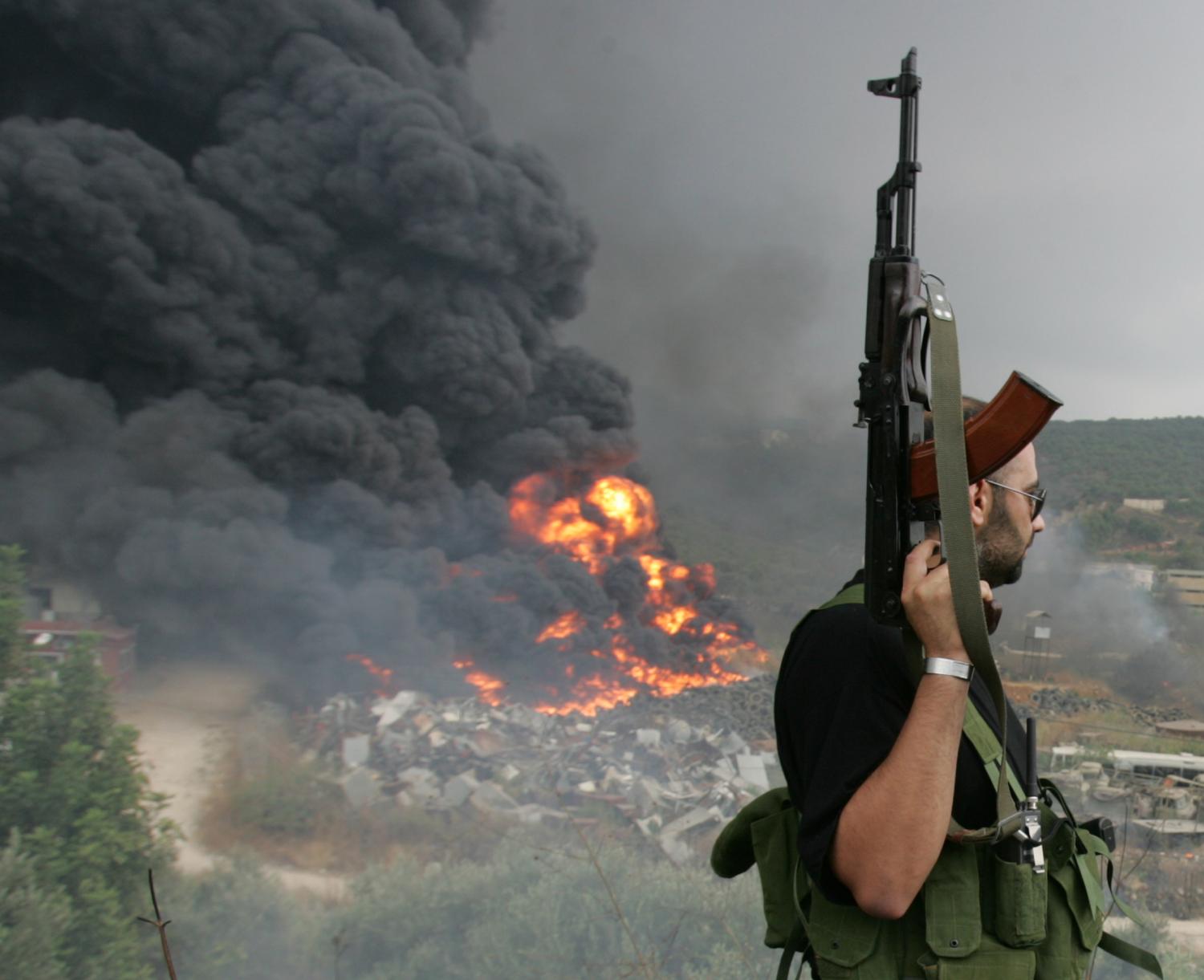
Hezbollah as Iran’s multi-purpose tool
For Iran, Hezbollah is a strategic asset that extends Iranian influence to the Mediterranean. Hezbollah’s rockets and missiles are tangible demonstration of the Islamic Republic’s anti-Israel credentials. But Hezbollah’s value to Tehran transcends the Lebanese theater. Hezbollah, like a “Beltway bandit” government subcontractor, has provided technical assistance and training to Iraqi militias supported by Iran and, more recently, Yemen. Hezbollah, when tasked by Tehran or Damascus, provides assassination services, with Hezbollah operatives indicted by the Special Tribunal for Lebanon for the February 2005 murder of former Lebanese Prime Minister Rafiq Hariri and under suspicion for the elimination of many other anti-Syrian and anti-Hezbollah Lebanese politicians in the 2005 to 2008 period.
For Iran, Hezbollah is a malevolent version of the Swiss Army knife, with special capabilities always at the ready for distinct tasks.
As the 1992 and 1994 suicide attacks against, respectively, the Israeli embassy and a Jewish center in Buenos Aires illustrate, Hezbollah’s terrorism does not stop at the Mediterranean water’s edge. More recently, Hezbollah stands accused of perpetrating the 2012 assault in Bulgaria against a bus of Israeli tourists and planning attacks, subsequently foiled, in Azerbaijan and Cyprus. Argentina announced the arrest of Hezbollah operatives in advance of the recent G-20 Summit. Hezbollah also developed the capability of helping Iran evade sanctions: Drawing on an extensive expatriate Lebanese Shiite population in Latin America and Africa, Hezbollah has mastered the criminal links of smuggling, money-laundering, and drug trafficking. Most importantly for Iran, Hezbollah fighters, backed by Russian air power, have been an essential part of Bashar al-Assad’s survival in Syria. Put simply, for Iran, Hezbollah is a malevolent version of the Swiss Army knife, with special capabilities always at the ready for distinct tasks.
Hezbollah as a Lebanese actor
When people would describe Hezbollah as a “state within a state,” Fred Hof, until recently at the Atlantic Council, would gently correct them, describing Hezbollah as “a state within a non-state.” Unlike other Lebanese militias that battled each other, Hezbollah evaded the disarmament requirements of the 1989 Taif Agreement by citing the Israeli occupation of southern Lebanon (and, sometimes, the very existence of Israel). Especially since the 2006 war, Iran has facilitated an exponential increase in the size, sophistication, and lethality of Hezbollah’s arsenal—a reality not lost upon other Lebanese political leaders and one-time warlords who willingly dismantled their militias in accordance with Taif.
Under Hassan Nasrallah, the new secretary-general who replaced Abbas Musawi (assassinated by Israel) in 1992, Hezbollah decided to participate in that year’s parliamentary elections for the first time, and Hezbollah has shifted more recently from having loyal allies in the cabinet to insisting its own members also take ministerial portfolios. Hopeful speculation that Hezbollah’s growing role in politics and governing would diminish the importance of its arms and transform Hezbollah into a “normal” party proved naive.
Today, Hezbollah uses the combination of its genuine popularity among the majority of Lebanon’s Shiites, its positions in Lebanon’s parliament and cabinet, and its militia power to exercise effective veto over any Lebanese government policy it opposes—while at the same time constructing an impenetrable wall against any public or parliamentary accountability over Hezbollah’s decisions. The recent Israeli discovery of Hezbollah tunnels from southern Lebanon into Israel is just the latest example of dangerous Hezbollah decisions, similar to its directive to kidnap Israeli soldiers from Israeli sovereign territory in July 2006, which could lead Lebanon to a devastating war—without any public debate, transparency, or governmental oversight.
Should any Lebanese question Hezbollah’s autonomous decisions, Hezbollah will deploy fighters and supporters to stifle physically the scrutiny (and, if needed, to eliminate the critic). When the Lebanese government in 2008 tried to dismantle an illegal Hezbollah telecommunications system, Hezbollah fighters physically seized control of West Beirut. Characteristic of its intolerance to others’ views, Hezbollah’s ability to mobilize intimidating mobs quickly has repeatedly thwarted any serious discussion of its arms or the special treatment it insists on assuming (but never bestowing).
A brief aside: Hezbollah, my mother, and me
A friend in Beirut enjoys amusing me by sending links to speeches by Hezbollah Secretary-General Hassan Nasrallah in which he invokes my name—as he did at least twice in 2018, a decade after I concluded my tenure as U.S. ambassador to Lebanon and six years after my last trip to Beirut, in May 2012 as assistant secretary of state for Near Eastern Affairs. My wife Mary teases me that, for Nasrallah, I serve the same function as Hillary Clinton does for President Trump: a way to excite the base.
Like other U.S. ambassadors in Lebanon and elsewhere, I was seen to personify the “Great Satan.” Until he feared alienating the embassy’s Christian neighbors he hoped his seduction of Michel Aoun would woo, Nasrallah deployed rent-a-mobs to weekly demonstrations outside the embassy gates. A fun byproduct was the vivid confirmation of how diplomatic service alters perspectives. Alarmed by the news coverage, my mother in small-town Ohio sent an e-mail to announce that she was flying to Beirut to join the Hezbollah protests, because, yes, Feltman did need to go home. Mary, a Foreign Service Officer then at Stanford, reacted to the same reports by asking where the protestors had found the image of me for the giant posters they were enthusiastically striking with their shoes—it’s a really good photograph, she noted. Live footage of me waving farewell to a ship evacuating U.S. citizens during the summer 2006 war also caught my mother’s attention: “Don’t wave to the ship; get on it!” her message advised.
Nasrallah’s use of me as a convenient stage prop peaked during the 2006-08 Hezbollah sit-in that paralyzed the government and crippled Beirut’s downtown over ministerial demands. Even inside the grand offices of the prime minister, the rhythmic Hezbollah chants attempting to discredit the cabinet of Prime Minister Fouad Siniora were audible: “Feltman government! Feltman government!” In one of my calls on him, Siniora reacted to a crescendo of chants by wearily joking: “Jeff, they say it’s your government: So take it!” A few years later, when as a U.N. official I joined U.N. Secretary-General Ban Ki-moon’s meeting with Iranian Supreme Leader Khamanei in Tehran, my Lebanese friends laughed: Was Nasrallah’s favorite object of scorn now discussing possible “Feltman governments” for Iran?
|
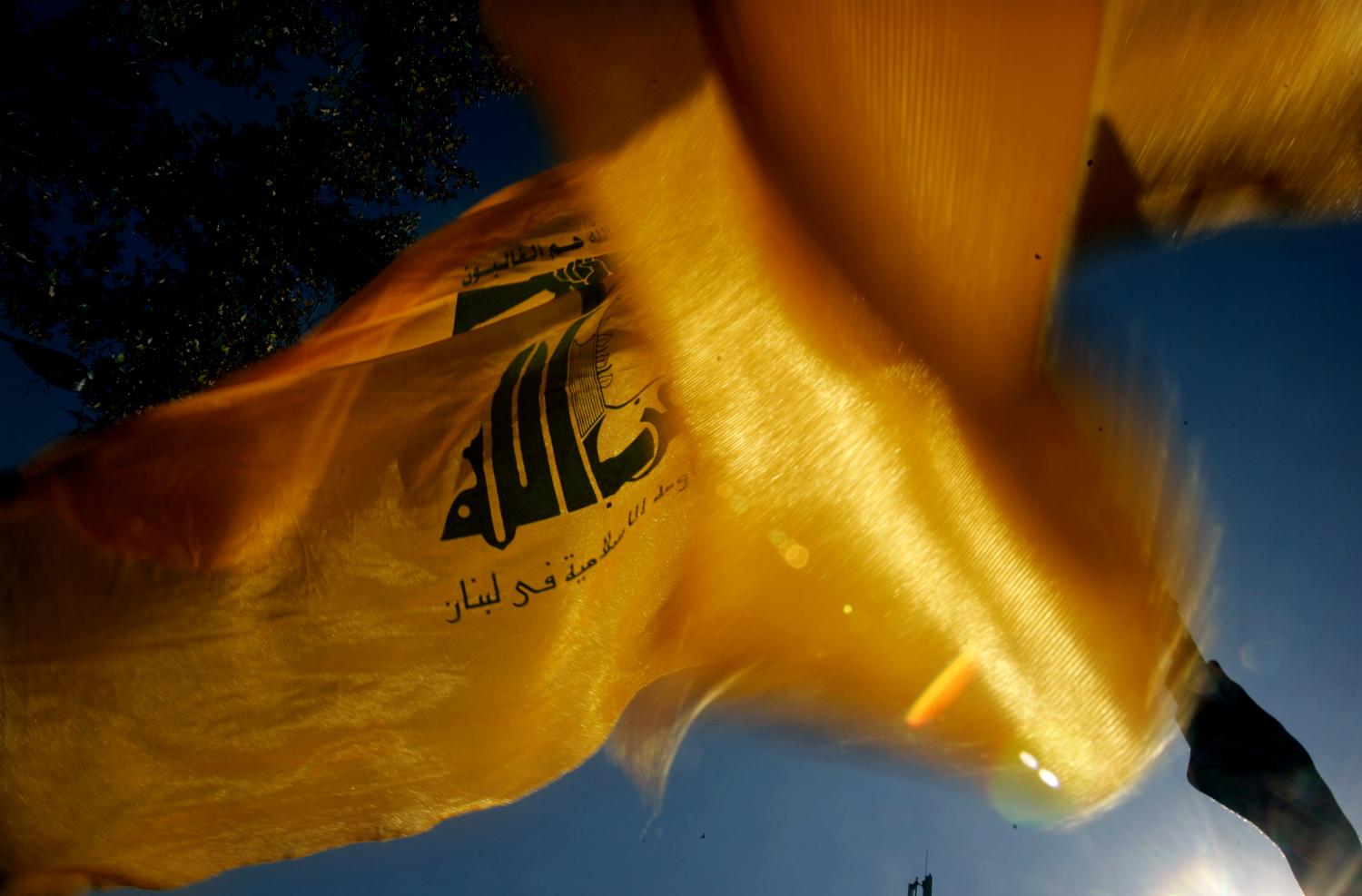
Michel Aoun provides Christian cover to Hezbollah
What gives Hezbollah particular potency in the current Lebanese environment is Hassan Nasrallah’s ability to assert that Hezbollah represents national Lebanese interests rather than narrow parochial Shiite goals or the positions of Tehran and Damascus. With political venality astonishing even by Lebanese standards, President Michel Aoun, a Maronite Christian whose followers once idolized him as the symbol of courageous resistance against Damascus, has embraced his role as Hezbollah’s enabler in this regard. His son-in-law, current Foreign Minister Gebrane Bassile, midwifed a 2006 memorandum of understanding between Aoun’s Free Patriotic Movement (FPM) and Hezbollah, and the two groups have maintained a close Shiite-Christian alliance ever since.
With their cult-like, personality-based followings, neither Aoun nor Nasrallah had to bother with the political acrobatics of trying to reconcile previous hostile positions with their 2006 bromance. Bassile in particular has been a notorious apologist for Hezbollah, insisting that Lebanon needs Hezbollah as defense against Israel (ignoring the reality that Hezbollah is primarily responsible for the threat from Israel that Bassile, like Nasrallah, cites as justification for Hezbollah’s arms). Even today, with the discovery of the tunnels into Israel, it is apparently impossible for President Aoun, who was by all accounts taken by surprise, to acknowledge that Hezbollah’s unaccountable behavior puts Lebanon at risk of war, undermines the very institutions of the state he was elected to lead, humiliates his own authority as president, and unveils the true nature of the supposedly equal partnership between the FPM and Hezbollah.
For Aoun, the memorandum of understanding (MOU) his son-in-law brokered with Hezbollah was a step on the route to achieving his long-standing ambition to be elected president, with his narcissism overriding his earlier opposition to Syria’s dominance of Lebanon. For Nasrallah, the MOU with a major Christian bloc was Hezbollah’s coming-out party as leading a national, rather than sectarian Shiite, movement. With the FPM’s Christian ministers and parliament members enthusiastically subservient to his objectives, Nasrallah has been able to exploit the peculiarities of Lebanon’s democracy to assert his will constitutionally.
For both leaders, their enduring alliance is also intended to sideline once and for all any independent political competition and, especially, to send a message to (and about) Lebanon’s Sunnis. In Lebanese-style race-baiting, Aoun’s FPM multiplies and exploits Lebanese Christian insecurities about the Sunnis. Given the well documented horrors of ISIS and a Lebanese Christian lifestyle as remote as imaginable from austere Saudi-style Wahhabism, FPM leaders argue that an alliance with Hezbollah is the best protection for the Christians against a hyped-up Sunni demographic, cultural, and security threat. The FPM-Hezbollah alliance is rooted on a narrative appealing to some Christians that Sunnis (portrayed as agents of Saudi Arabia) are a bigger danger to Lebanon than a heavily armed, religious-based political movement contemptuous of public oversight and allied with mullahs in Tehran and a serial murderer in Damascus. Some particularly delusional FPM members even argue that, despite the relative demographic decline of Christians in Lebanon, Hezbollah will help them reverse the re-balancing of Christian-Muslim political power that was part of the 1989 Taif Agreement that Aoun despises.
Having succeeded with astonishing ease in co-opting Aoun and those Christian who follow him, Nasrallah spent weeks blocking Lebanon’s current cabinet formation by insisting that individual Sunni proxies of Hezbollah, who won parliamentary seats in districts with significant Hezbollah voters, be awarded cabinet representation at the expense of caretaker Prime Minister Saad Hariri’s larger and more representative Sunni bloc. With the ludicrous Druze politician Talal Arslan already parroting Hezbollah positions, Nasrallah now seeks to create an equally pliable Sunni version of Michel Aoun, to allow Hezbollah to claim Sunni credibility as well. Nasrallah may not yet have the power to name the prime minister in the same way that he appealed to Aoun’s vanity to create the Aoun presidency, but he is patiently expanding his alliances. Considering the uncanny similarity of the challenges provoked by Shiite militias in the post-election Iraq government formation exercise, the question is whether this is all part of the unseemly business of local Lebanese politics or whether Nasrallah is also representing Iranian designs of wielding power through both militias and constitutional positions. After all, Nasrallah’s attempts to use Aoun’s ready acquiescence and Hezbollah’s militia to monopolize internal Lebanese politics would not be contradictory to Iran’s regional ambitions.
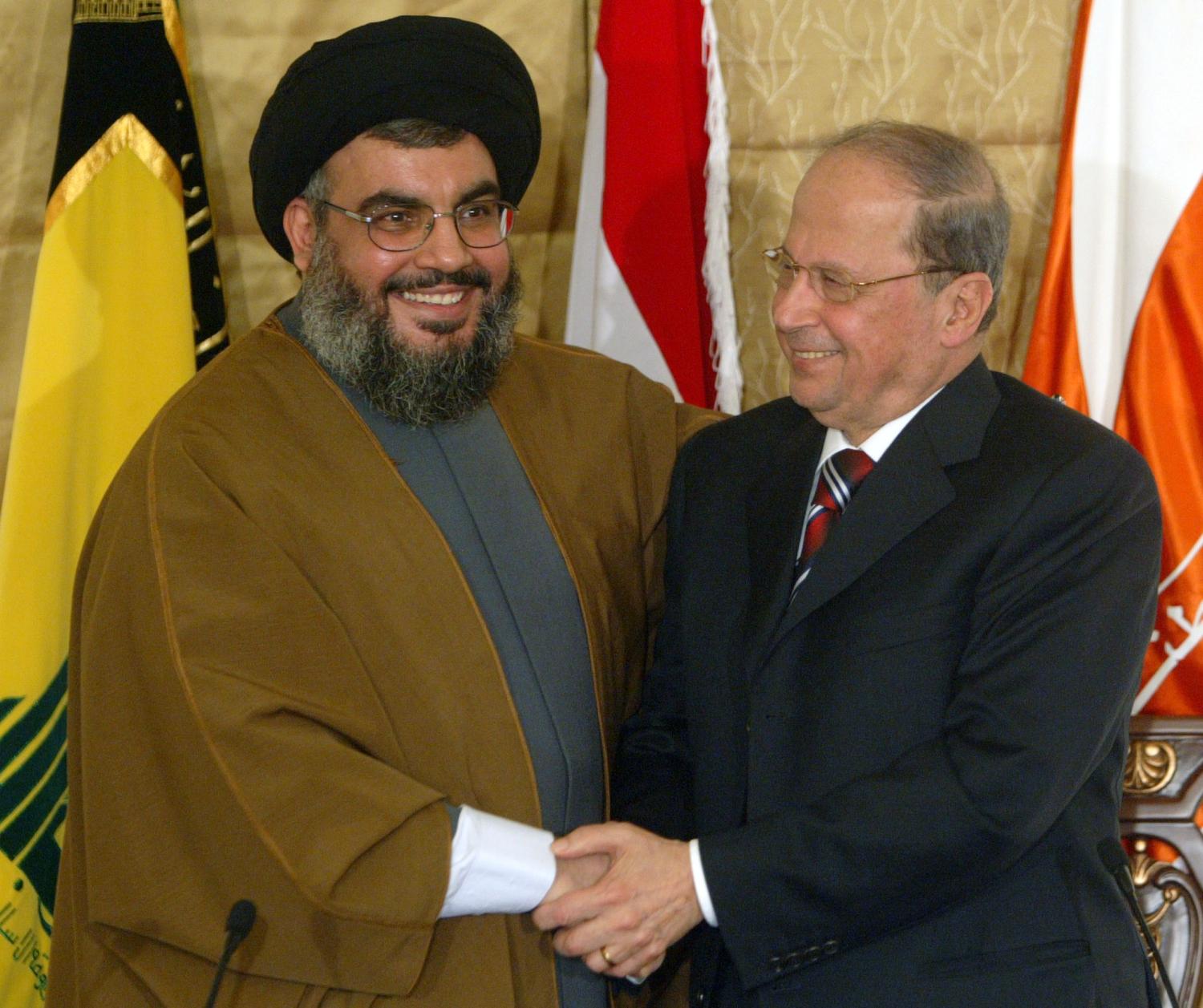
Hezbollah today, and lessons
Hezbollah, as a force multiplier for Iran and threat to Israel, is stronger militarily than ever.
Iranian leaders can look with satisfaction on what their nearly four-decade investment in Lebanon has yielded. With its fighters having experienced real-world battles over several years in Syria and due to its expanded and sophisticated military arsenal, Hezbollah, as a force multiplier for Iran and threat to Israel, is stronger militarily than ever. It is also clear now that the Iran-style Islamic Republic demanded in Hezbollah’s 1985 manifesto (and now conveniently ignored by Nasrallah and Aoun alike) is not essential to Hezbollah’s ability to protect its own, and Iran’s, interests. The alliance with Michel Aoun gives Hezbollah constitutional levers to manipulate and paralyze the government at will, while Hezbollah has successfully demonstrated that it can use intimidation and threats to prevent public scrutiny and debate over its arms. Moreover, given demographic realities, momentum is building behind an idea for further revisions to Lebanon’s confessional divide—shifting from 50-50 Christian-Muslim to equal thirds for Christians, Sunnis, and Shiites. If ever enacted, such revisions would essentially assure Hezbollah, given its dominance over Shiite politics, of a permanent, constitutional “blocking third” over important parliamentary and government decisions, without having to worry whether the alliance with the FPM will outlive Aoun.1 Finally, Iran can anticipate that an increasing number of self-serving Lebanese political figures, anticipating how the regional and international political winds are blowing, may decide that joining the Tehran-Damascus-Hezbollah alliance is the safe bet, especially given uncertainties about American leadership and reliability in light of the Trump administration decision to withdraw U.S. forces from Syria.
Yet perceptive Iranian analysts might detect some emerging, cautionary trends; all is not well in Hezbollah’s earthly Lebanese paradise. Demobilized Hezbollah fighters from Syria return to Lebanon with no job prospects (and fewer abilities than other Lebanese to migrate or work abroad). Hezbollah is reportedly struggling to cope with former fighters with PTSD, drug addiction, or thuggish behavior incubated in Syria’s lawless environment. Late salaries to Hezbollah’s social service employees and delayed payments to suppliers are interpreted as signs that U.S. sanctions against Iran and Hezbollah are taking a toll. Hezbollah’s insistence on getting the Health Ministry in the new cabinet can be explained in part to burnish its credentials in terms of relatively honest service delivery, but it does not seem to be a coincidence that control of the Health Ministry gives Hezbollah authority over significant amounts of cash. (While larger in terms of amounts, the budgets of the Defense, Education, and Interior ministries are mostly mortgaged to salaries and pensions; the Health Ministry, by contrast, has discretionary funds.) The Lebanese Armed Forces (LAF), while devoid of the offensive rockets and missiles of Hezbollah, are an increasingly coherent and sophisticated military defense force, thanks in large measure to years of patient U.S. support. In light of the LAF’s improved capacities, Nasrallah’s arguments that Hezbollah is needed to defend Lebanon begin to sound increasingly hollow, especially when, as with the tunnels and in 2006, Hezbollah is the party most responsible for placing Lebanon in danger of a catastrophic war.
Given the Trump administration’s stated policy of pressuring Iran, it seems an opportune time for increased focus on Hezbollah, revolutionary Iran’s most successful export and one of its primary tools for deadly mischief regionally and internationally. As the Israeli experience has shown, a purely military approach to Hezbollah provides, at best, only temporary setbacks. Questions to consider include how to prevent a blurring between the LAF and Hezbollah—which, with careful diplomacy, should be possible, given the LAF’s improved capacities and the resentment many proud LAF officers quietly voice about Hezbollah’s arrogance. Related, it is time for the United States at last to contemplate seriously how to show FPM officials and supporters, many of whom have ties to the United States, that there are consequences in terms of their relations with the United States for the FPM’s alliance with a designated terrorist organization with American blood on its hands. Bassile’s slavish embrace of Hezbollah, for example, should not be cost-free in terms of his access to Washington officials. Scrutiny of World Bank commitments in light of what ministries fall under Hezbollah’s control in the new cabinet also seems wise. Decisive, rapid U.S. action along these lines can help mitigate the impression in Lebanon, after the Syria troop withdrawal decision, that the U.S. has lost interest and influence in the region and that Washington’s Iran policy is rhetorical only.
More broadly, the United States might consider how to work with others to prevent the emergence of other Hezbollah-like entities elsewhere in the region. The benefit of hindsight shows clearly what those Islamic Revolutionary Guard Corps (IRGC) trainers in the Biqa’ Valley and the Iranian subsidies of jobs and services did in terms of creating momentum behind Hezbollah’s growth. But for something even that heavily subsidized to take permanent root and flourish, fertile ground is required. The utter neglect, for decades, of Lebanon’s Shiite population by the Sunni-Maronite elite and the Shiite feudal families, exacerbated by the contempt for, and brutality toward, the locals demonstrated by the Palestinians and Israelis in southern Lebanon, prepared the land for the seeds Iran then planted and nurtured. Unlike Michel Aoun’s calculated embrace of Hezbollah, the Lebanese Shiites did not collectively decide one day to become tools of Iran (and many still resent having their political interests hijacked by Hezbollah and Iran). But devoid of prospects for respect and a better future, they gravitated to the opportunities Iran provided in nascent Hezbollah.
The leaders of Bahrain, Saudi Arabia, and the supporters of Yemen’s recognized government need to consider whether they are creating the very conditions by which a portion of their own citizenry, whose political and professional aspirations seem constantly thwarted, will at some point, in frustration, give up on their own national leaders and see no alternative to the offers of help Iran will be willing to extend (even in its own straightened financial condition). These countries risk making the same mistakes the Lebanese elite committed in creating the opportunity Iran was all too happy to exploit.
-
Footnotes
- Constitutionally, to prevent domination by one religious group, important government decisions or parliamentary legislation in Lebanon need to pass by a two-thirds majority. So even if the Shiite proportion of positions increases from its current 21 percent to one-third of the total under the idea being discussed, Hezbollah—which can be assured of all Shiite votes—would need one additional supporter for the “blocking third.” Given Hezbollah’s various levers of power, finding a single Sunni, Druze, or Christian vote would be easy.
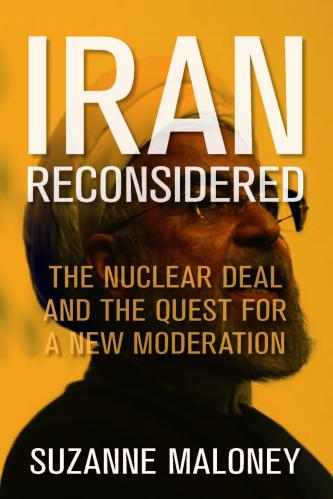
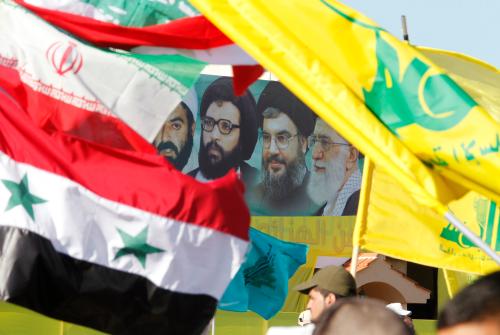
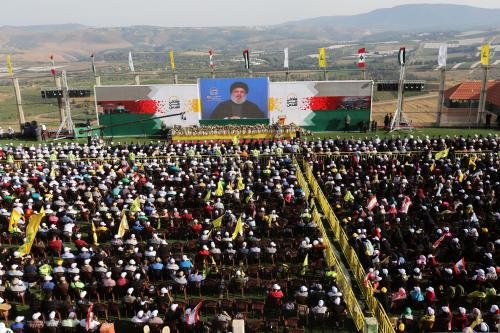
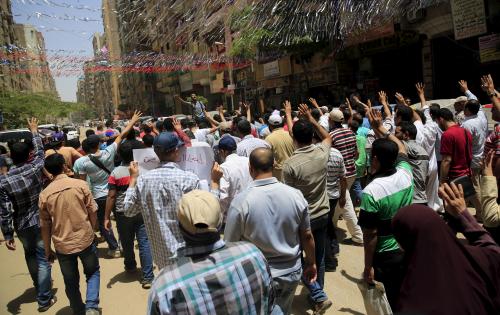


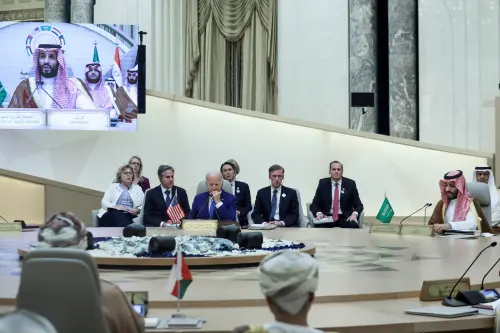
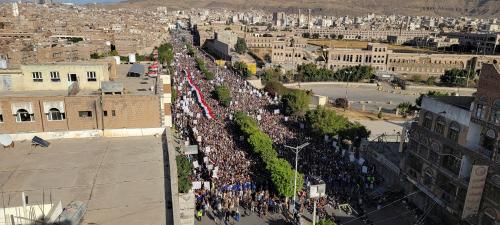
Commentary
Op-edHezbollah: Revolutionary Iran’s most successful export
January 17, 2019